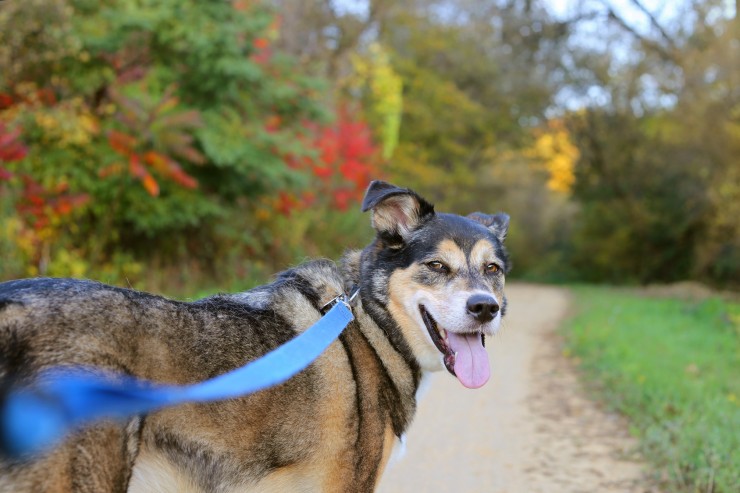

Diabetes is a complex condition that can affect dogs as well as people, and as the condition cannot be cured or reversed, caring for a diabetic dog is something that requires a reasonable amount of vigilance, forward planning and experience on the part of the owner, as diabetes can affect virtually every element of the dog’s life and general wellbeing.
Keeping the diabetic dog healthy relies on a variety of different things, including maintaining their weight, feeding them an appropriate diet, administering the right amount of insulin, knowing what to do if something goes wrong, and being able to identify changes and imbalances in your dog’s condition in order to keep the balance just right.
The diet of the diabetic dog, in combination with their insulin levels, is one of the most important aspects of diabetic dog care, but exercise too is another factor that affects both food intake, the processing of food and calories into energy, and so, insulin levels and the dog’s blood-sugar balance.
In this article, we will look at the role of exercise in the management of canine diabetes, and the challenges that can accompany exercising the diabetic dog.
First of all, it is important to develop a good basic grounding in your understanding of canine diabetes, what its action is and how it is controlled, which you can find out about in more detail within this article.
Maintaining a healthy weight is vital to the health of the diabetic dog, as obesity can actually cause or exacerbate diabetes, and if your dog is diagnosed as diabetic and is also overweight, bringing them back down to within healthy weight parameters can greatly improve their health and make their diabetes far less acute.
If your dog is overweight at the time that they are diagnosed with diabetes, your vet will help you to draw up a comprehensive exercise plan to help to bring them back down to a healthy weight, in combination with balancing out their diet and insulin levels to match.
If your dog is at a healthy weight at the time of diagnosis, you will likely be encouraged to keep exercising them in the same way as before their diagnosis, and their new diet and supplementary insulin administration will be planned accordingly.
Exercise is a vital part of helping to keep your dog’s diabetes under control, for a variety of reasons. Not only does it help to keep your dog within healthy weight norms, but because exercise burns energy or calories, it helps to put the glucose in your dog’s body to work to support this, enabling your dog’s glucose levels to remain within healthy norms and be less likely to go through peaks and troughs throughout the day.
Added to this, exercise boosts the blood flow and circulation, which helps to circulate insulin throughout the body, and improve its uptake rate at a cellular level, again, helping to keep everything in balance.
Whilst insulin-dependent diabetic people will test their blood-sugar balance and administer their own insulin throughout the day as needed to keep it level, depending on what they are eating and how active they are, the type of insulin supplied for dogs is slow-release, and designed to be given just twice a day in order to keep their systems in balance.
This means that assuming that the dog eats the same food at the same times and in the same quantities each day, and exercises in the same way and for the same amount of time too, your dog’s regular insulin administration twice a day will be tailored to match this, and will not need constant alteration.
However, if your dog’s exercise levels change or vary a lot, such as if your dog is particularly active on one day, or misses a day of exercise entirely, this can throw the whole delicate balance out of whack, potentially leading to problems such as hypoglycaemia or hyperglycaemia.
This means that not only should your dog’s diet, feeding times and insulin administration follow the same pattern day in and day out, but so should their exercise levels and exertion, in order to keep everything in balance.
If at any time, your dog cannot be exercised for some reason or if you want to make changes to their exercise regime, you should do this in consultation with your vet, who will be able to advise you and make adjustments to your dog’s diet and insulin levels accordingly.
It is a good idea for owners of diabetic dogs to keep some essentials with them when out walking with their dog, in order to be able to manage and control things if something goes wrong or any unforeseen changes occur.
Firstly, it is a good idea to get your dog a collar and/or lead that says “do not feed” on it, to reduce the chances of a well-meaning stranger giving your dog a snack without your permission, and you should also consider carrying a snack for your dog in case of hypoglycaemia, a testing kit in case your dog appears to be suffering from an imbalance, and, if you will be out for any length of time, insulin supplies too.
 Understanding Gerbil Behaviour
Understanding Ger
Understanding Gerbil Behaviour
Understanding Ger
 Six Ways To Tell If Your Dog Food Is Worth The Price You Pay
Six Ways To Tell
Six Ways To Tell If Your Dog Food Is Worth The Price You Pay
Six Ways To Tell
 More Information On Familial Shar-pei Fever
More Information
More Information On Familial Shar-pei Fever
More Information
 Leave It! Five Simple Steps To Training Your Dog Away From Your Possessions
Leave It! Five Si
Leave It! Five Simple Steps To Training Your Dog Away From Your Possessions
Leave It! Five Si
 Five Universal Personality Traits Of The Ragdoll Cat
Five Universal Pe
Five Universal Personality Traits Of The Ragdoll Cat
Five Universal Pe
Copyright © 2005-2016 Pet Information All Rights Reserved
Contact us: www162date@outlook.com